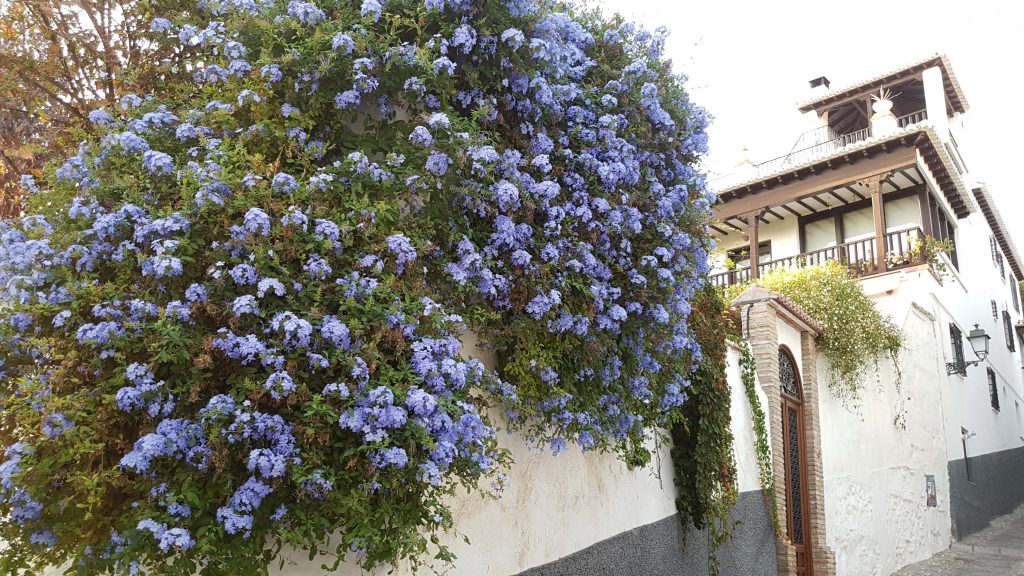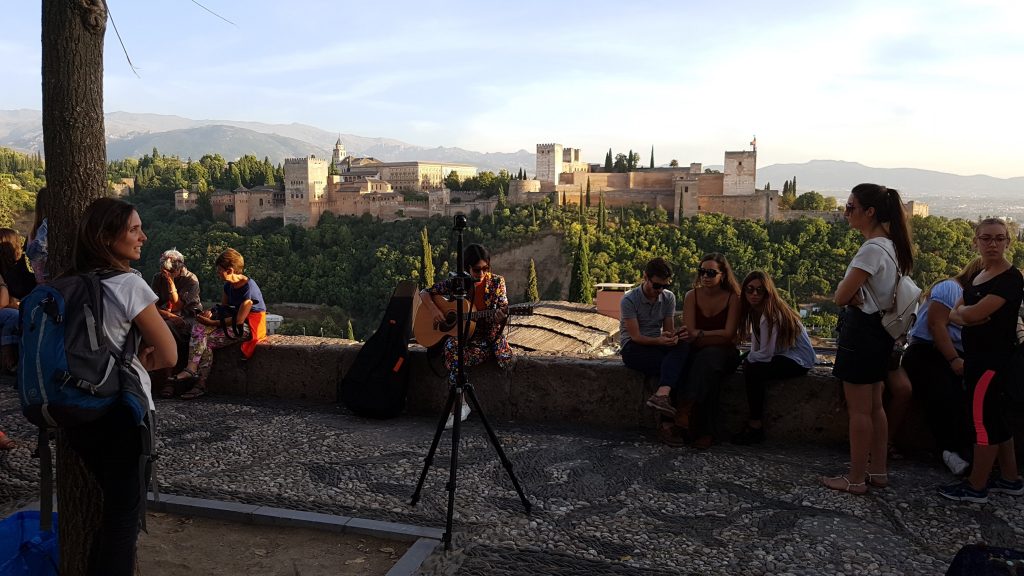Granada, much more than the Alhambra and good tapas….
Granada is one of the most beautiful cities in Spain. Its magic captivates. Many travelers came to Granada and fell in love with its charm and decided to stay here forever.
Granada is famous for the Alhambra, a fortress complex built during the Nasrid Kingdom in the mid-13th century. The Alhambra is the most visited monument in Spain after the Sagrada Familia in Barcelona.
Granada is also famous for its young atmosphere fostered by having one of the best Universities in Spain and for its tourism…. Tapas bars are here legend, where for the price of a drink they serve complimentary, exquisite portions of food, the “tapas” totally free!
But Granada is much more than the Alhambra, than tapas, than its fun atmosphere …
In Granada, art walks through its streets, from a wonderful old town in the center of the city to the Albaicin and Sacromonte neighborhoods. There is a lot to see and visit in Granada, its bustling streets, its open people. The Province of Granada is bathed by the Mediterranean sea of the Costa Tropical and also has one of the highest mountain ranges in Europe, the Sierra Nevada.
When you visit Granada, let yourself be captivated by its history, its people and the charm of this unique city in Spain.
You cannot leave Granada without visiting…
The Alhambra
The first must-see in Granada is the Alhambra. Let yourself be carried away by its overwhelming beauty. About a million tourists travel to Granada every year to visit this monument named a World Heritage Site by UNESCO.

The name “Alhambra” derives from the Arabic “qa’lat al-Hamra” or red fortress, due to the color of its walls. The buildings that make up this monument are located on top of the hill of La Sabika from where it dominates the city of Granada.
The first vestiges of the Alhambra date back to the 9th century, but it was not until the 13th century that the first Nasrid monarch, Mohamed ben Al-Hamar, converted it into a royal residence and began its period of greatest splendor.
The Alhambra is a citadel with several buildings or areas, the Alcazaba (military fortress), the Medina (a kind of market city that the court used), the Palaces, the Generalife (a place of distraction and entertainment). Places as famous and recognizable as the Patio de los Leones, the Patio de los Arrayanes and the Rooms of the Two Sisters and the Kings, or the Hall of the Ambassadors form a unique complex due to its harmony and spirituality.
Granada Cathedral
Both the Cathedral and the Royal Chapel reveal the importance that this city had for the Catholic Kings.
The Cathedral began to be built in the Gothic style in 1523 and it was finished but in the Renaissance style in 1704, it was his grandson Carlos V who was in charge of finishing it.
The Royal Chapel is found just outside the Cathedral. The Catholic Monarchs ordered it to be built in 1504 and it is the place they chose to be buried, again his grandson Charles V would take care of its completion and turn it into the pantheon of the royal family dynasty.
Albaicin
The Albaicín is the oldest neighborhood in Granada and is located on a hill from where you can enjoy views of the Alhambra. Its narrow streets recall the typical streets of an Arab neighborhood and it has many cisterns.
Before the Alhambra was built, the Albaicín was already a Muslim court.
In the 11th century, the Ziri dynasty built its royal palace there, surrounded by sumptuous fortresses, important Islamic buildings and temples. They also built the city’s Great Mosque here.

The time of greatest splendor of the Albaicín took place during the Nasrid dynasty, when it had a population of more than forty thousand inhabitants and thirty mosques. The city descended by San Nicolás to the banks of the Darro River, populated with luxurious houses and equipped with splendid public baths. After the Conquest by the Catholic Monarchs, the Albaicín was assigned to the Muslims as a place of residence and little by little they were left apart there.
After several Moorish uprisings, the Castilian monarchs expelled all those who practiced the Muslim religion and all the mosques were demolished.
The neighborhood of the thousand mosques became the neighborhood of the thousand churches, and at the beginning of the 17th century the Moors permanently abandoned their houses in the Albaicín.
The rich Christians who lived in the Medina took advantage of the opportunity and built their sumptuous mansions, typically called “carmenes”, in the Albaicín.
The Albaicín also has numerous tea shops that are highly recommended to get into the atmosphere and get some strength to continue enjoying Granada.
The Albaicín was declared a World Heritage Site by UNESCO in 1994 for its outstanding universal value.
Mirador de San Nicolas (Saint Nicholas’ lookout)
One of the most famous viewpoints in the Albaicín is the San Nicolas viewpoint. From there you can see the entire monumental complex of the Alhambra with the city at its feet and Sierra Nevada behind. It is no coincidence that it is one of the most photographed sunsets in Spain.

Sacromonte
Gypsies from the 18th century settled on the slopes of Cerro de San Miguel and on the shore of the Camino del Sacromonte, the old Muslim road to Guadix, and they made the land their own by developing a new type of housing: the cave.
The Sacromonte caves are grouped around ravines, thus forming a kind of streets. There are caves of various types.
The best known are those dedicated to flamenco shows, here called Zambras. These caves are spacious, white, and adorned with shiny copper pots.

They are located near the road and are easily accessible. The most popular are the Cueva de María la Canastera or the Cueva de La Rocío. Tickets are usually reserved in advance through their website or by phone.
In the upper areas of the Sacromonte there were the most humble caves, where the entrance served as a kitchen and dining room and had only one or two bedrooms.
It is essential to visit this mythical place one night to attend a gypsy zambra in a cave in Sacromonte.
Nowhere else will you be able to see a spectacle like it. The zambras reflect the rich cultural mix that was forged in Sacromonte over centuries. In it there are reflections of Muslim festivals that the gypsies assimilated and then made their own.
The show has a very particular content, which stages a gypsy wedding, and a special way of representing it, without tablao or stage; in a circle, very close to the viewer.
Cartuja Monastery
It is worth spending a morning to visit the Cartuja Monastery, it is in the Baroque style. It is one of the most important places you can see in Granada of Catholic worship, along with the Cathedral and the Royal Chapel.
Other excursions within the province of Granada that will excite you …
The Sierra Nevada Ski Resort
Sierra Nevada is the highest mountain massif in Western Europe after the Alps. It will be easy for the traveler to reach the mountain, about 35 kilometers from the center of Granada, turned into a highway for most of the journey. By the highest road in Europe the traveler reaches the Pradollano ski resort. It is the ski resort with the most sunny days a year in all of Europe and offers more than 100 skiable kilometers.
The Alpujarra
On the slopes of the Sierra Nevada we can find white villages that seem to fall from the mountain and with mainly Moorish architecture. Its architecture is mainly Moorish. After the reconquest of Granada they were repopulated by Galicians and Leonese. Pampaneira, Capileira and Bubión are three of the most typical towns in the Alpujarra.
Tropical coast
The coast of Granada receives as eloquent a name as Costa Tropical due to its excellent, almost tropical climate, in which in addition to enjoying the sun for much of the year, many tropical fruits are also grown, such as cherimoya. With 75 kilometers of extension, Motril, Calahonda, Salobreña or Almuñecar are some of its best known towns.

Granada, a benchmark for flamenco
Granada is undoubtedly one of the greatest flamenco references in Spain. The gypsy neighborhood of Granada’s Sacromonte is considered one of the epicenters of flamenco worldwide, and its singing and dancing dates back to the nuptial rituals of the Moors during the 16th century. This gave rise to the “zambra”, a great gypsy festival, a sublime expression of the “jondura” and the “duende” flamencos.
The flamenco schools of Granada are internationally renowned and the University of Granada obtained the first Chair of Flamencology in the world.
As we have seen, Granada is much more than the Alhambra and good tapas … Granada deserves a visit, a long stay and who knows … maybe a lifetime.


